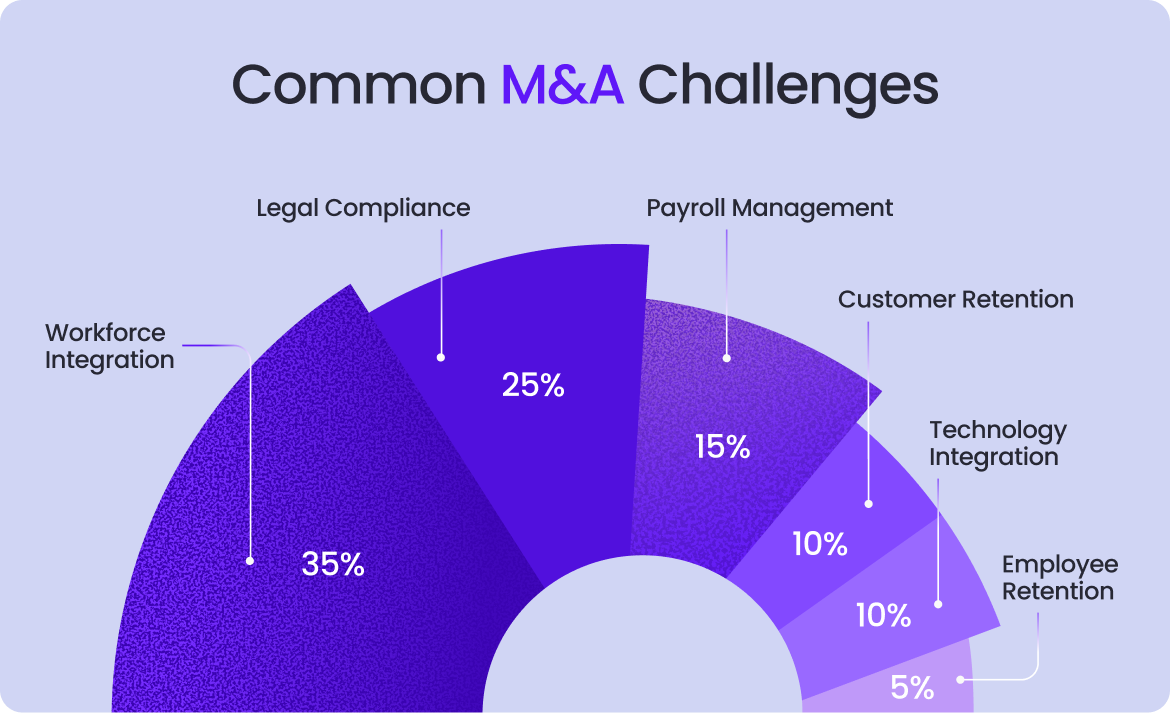Copied to Clipboard
Ready to get Started?


Key Takeaways
Mergers and acquisitions can be great opportunities for growth but come with integration challenges, especially in workforce alignment, legal compliance, and payroll management.
Choosing the right type of M&A depends on your business goals, market conditions, and resources.
Effective solutions, like automating payroll and engaging legal experts, can ease the integration process and help avoid costly mistakes.
Mergers and acquisitions (M&As) can be your gateway to supercharge your company growth and market share. They are deals that can include everything from a company buying a direct competitor to combining with a supplier further up the supply chain, or even selling different related products within the same market.
M&A’s can help boost growth and provide a competitive edge, but also come with their fair share of challenges. If you're in HR or overseeing the global expansion of a team, you probably know that the real work with M&A’s begins after the deal is done. Merging teams, aligning company cultures, and making sure payroll runs smoothly across borders can get complicated fast.
In this guide, we talk you through what M&As are, the different types that you might come across – and how to handle some common challenges that often pop up.
What Are Mergers and Acquisitions (M&A)?
Mergers and acquisitions (M&As) are when two companies either join together or one company buys the other.
- A merger happens when two companies decide to combine into one new company. Think of it like two people deciding to join forces to start a new project together.
- An acquisition is when one company buys another. Typically a bigger company, called the acquiring company, will absorb a smaller company.
After a merger or acquisition, the leadership structure of a merged company may include a board of directors, often made up of members from both original companies, to represent their combined interests.
Both mergers and acquisitions are great ways for companies to grow, expand their product lines, or streamline their business operations, either by expanding what they already do or by adding something new. M&As can help companies reach new customers, save money, or get better at what they do. They can happen in any industry, but are particularly common in the healthcare, technology, financial, and retail industries.
While an M&A deal may sound sweet and straightforward, the integration of the teams, policies, and payroll systems can be anything but easy.
6 Types of Mergers and Acquisitions & Examples
When your company is thinking about a merger or acquisition (M&A), it helps to understand the different options available. Each type of M&A has its own purpose and can help your business grow in different ways – whether that’s cutting costs, reaching new markets, or globally expanding your product offerings.
Choosing the right path is key to setting your company up for long-term success, but it’s important to think about your business goals, your growth strategy, the current market, and what challenges each option might bring.
Let’s break down your options:
1. Horizontal Mergers
A horizontal merger happens when two companies in the same market and offering similar products or services decide to join forces. The primary goal is usually to take on competitors, reduce duplication, and increase market share.
Why It Helps a Company:
This type of merger allows companies to increase their competitive advantage, reduce costs through economies of scale, and expand their customer base by combining resources. The merged company has the potential then to become the dominant player and strengthen its product or service offering.
Real-World Example:
A great example of a horizontal merger is the 2015 merger between Heinz and Kraft. Both were in the food industry, offering similar products like condiments and snacks. By merging, they could reduce operational costs and expand their reach in global markets. The merger helped them achieve better operational efficiency and leverage their combined market power.
2. Vertical Mergers
A vertical merger occurs when a company combines with another company that operates at a different layer or level of the supply chain – for example, a manufacturer of wooly socks merging with a supplier or distributor of wool. This type of merger allows the company to take control of more stages of the production process, cut costs, and improve efficiency.
Why It Helps a Company:
Vertical mergers give companies more control over the supply chain of a product. This in turn will likely result in smoother operations and less of a reliance on third-party suppliers. It also helps streamline operations and reduce expenses in the production process.
Real-World Example:
Amazon acquired Whole Foods Market in 2017 for $13.7 billion, a strategic move that allowed Amazon to integrate its e-commerce capabilities with physical retail operations. This ultimately improved its grocery delivery services and expanded its presence in the brick-and-mortar retail sector.
3. Conglomerate Mergers
In a conglomerate merger, two companies in unrelated industries come together. This type of merger allows companies to diversify their business, ultimately reducing risks associated with relying on a single market or sector.
Why It Helps a Company:
Conglomerate mergers allow companies to spread risk by entering new markets and industries. They usually happen when two companies believe they can grow faster together, than they can on their own. When two successful companies merge with one another, they can stabilize earnings and offer better protection against economic downturns in any one sector.
Real-World Example:
In 1995, Disney acquired ABC Inc. in a $19 billion deal, dubbing it the second-largest corporate takeover of its time. Disney was primarily an entertainment company, while ABC was primarily a broadcasting company, albeit one of the Big Three broadcast networks. By merging with ABC Inc., Disney was able to enter the broadcasting industry and completely diversify its portfolio, gaining access to an entirely new audience.
4. Market Extension Mergers
A market extension merger happens when two companies that sell the same type of product or service in different markets, decide to merge. For example, let’s say one company sells its products in the U.S., and another company sells the same products in Europe. If these two companies merge, they can now sell their products in both regions.
Why It Helps a Company:
This type of merger means companies can both diversify their product or service offering and extend their reach, ultimately increasing their market presence. This naturally then opens up doors to new customer bases. It's a great way to grow a brand by entering new areas without having to build from scratch.
Real-World Example:
In 2002, RBC Centura (The Royal Bank of Canada) merged with Eagle Bancshares. This market extension merger gave the Canadian company access to $1.1 billion in assets and new geographic regions to grow its customer base. Ultimately what the merger did was give RBC the resources it needed to plant roots in the North American market.
5. Product Extension Mergers
In a product extension merger, two companies that are selling different but related products in the same market decide to merge. They join forces to expand their product offerings and reach more customers.
Let’s say Company A that sells smartphones and Company B that sells smartphone accessories work independently from one another. If they merge, they can offer a full range of products to the same customers. Customers who buy smartphones from one company can now also conveniently buy the accessories, and vice versa.
Why It Helps a Company:
This merger helps companies diversify their product lines while staying within a familiar market. It creates cross-selling opportunities and helps businesses expand their customer base by offering a wider variety of products.
Real-World Example:
A notable product extension merger occurred when Mobilink Telecom merged with Broadcom. Both companies operated in the electronic industry with broadcom selling chips and software for broadband networks and Mobilink Telecom offering chips for cellphones. By merging, the two companies were able to integrate their technologies, offering customers more comprehensive telecom and tech solutions.
6. Acquisition
An acquisition is a type of merger or acquisition where a company buys another company not for its products or services, but specifically to acquire its team or talent. The main goal is to bring in the skills, expertise, and knowledge of the employees rather than gaining any physical assets or intellectual property.
This type of merger or acquisition is particularly common in the tech industry, where skilled developers, engineers, or other specialist skills are high in-demand.
Why It Helps a Company:
Acquires help companies gain top talent quickly and add a skilled workforce without having to go through the lengthy process of hiring individuals. It’s often used in industries where talent is highly valued, such as Artificial Intelligence (AI) and Machine Learning (ML) or Cyber Security.
Real-World Example:
In 2012, Facebook acquired Instagram in a famous $1 billion acquisition deal. While Instagram’s app was valuable, Facebook was primarily interested in the talented team behind the app, specifically its engineers and developers. By acquiring them, Facebook could improve its own product offerings and speed up its development process.
Each type of M&A serves a different business purpose, and understanding the potential benefits can help you determine which approach is right for your company’s growth strategy. Whether you're looking to take on competitors, control your supply chain, or gain top talent, M&As can be a powerful way to scale and improve efficiency.
Common Challenges and How to Overcome Them
M&As can change the course of a business, but they aren’t always smooth sailing. In fact, studies show that between 70% and 90% of M&As don’t hit their strategic goals, mostly due to integration problems.
Here are a few of the most common challenges that you might encounter during a M&A:
- Workforce Integration: Merging different company cultures and HR policies can cause frustration and confusion for employees. Getting the teams on the same page takes careful planning and communication.
- Legal Compliance: When you’re operating across borders, dealing with different labor laws, tax codes, and regulations can get overwhelming. It’s easy to miss something, and the consequences of that can be costly and legally damaging.
- Payroll Management: Managing payroll across multiple regions with different currencies and regulations? Not exactly a walk in the park. It can be time-consuming and error-prone.
- Business Operations Integration: Aligning IT systems, customer databases, and even supply chains requires thorough planning and collaboration.
- Employee Retention: M&As often create a feeling of uncertainty, and when key employees aren’t given enough support or reassurance, they may leave, which can affect productivity, morale, and the success of the merger.

Solutions for Businesses
Navigating the tangled web of local laws, cultural differences, and compliance requirements during an M&A can quickly overwhelm even the most experienced business leaders. Thankfully, there are tried and tested effective strategies you can implement to smooth out these bumps along the way.
- Automate Payroll and Compliance Across Borders: With advanced payroll software, you can automate your payroll and make sure all employees (exiting and new) are paid correctly and on time, all in one dashboard and while remaining fully compliant with local laws.
- Keep Data Secure with Cloud-Based Systems: During complex transitions, when you’re dealing with sensitive employee data and integrating teams across borders, advanced security features like built-in encryption and secure access controls are non-negotiables.
- Workforce Integration: Prioritize clear communication and get leadership teams on the same page to define the new entity's vision and values. Structured onboarding, training programs, and regular updates will help employees transition smoothly and understand the new culture.
- Legal Compliance: Engage legal experts or an experienced Employer of Record) partner in cross-border M&As to help you navigate local labor laws, tax codes, and industry regulations. A comprehensive integration plan will identify potential risks and help avoid any legal issues down the line.
- Employee Retention: Maintain open communication lines and offer career development opportunities to reduce uncertainty. Incentives like retention bonuses and career counseling, alongside a strong employee engagement strategy, can boost morale and reduce turnover.
Understanding EOR Services in M&As
An Employer of Record (EOR) is a third-party service provider that assumes the legal responsibility for payroll, benefits and compliance across borders. This is especially helpful during an M&A, because the EOR can handle managing the workforce from different legal jurisdictions. This makes it easier to keep everything compliant and operational without adding the extra burden of setting up a foreign entity or subsidiary to your HR team.
Benefits of Using an EOR for M&As
When you're in the middle of a merger or acquisition, time is of the essence. Partnering with an EOR will enable your company to scale internationally without the unnecessary delays of setting up new legal entities, giving you the flexibility to hire, onboard, and manage teams quickly across borders.
Time Saved & Simplified HR Management Across Borders
During an M&A, you're likely dealing with employees from the acquired company, new hires across different regions, or even transitioning teams to a new system. Setting up a legal entity in a new country can take months, which is unnecessarily complicated and expensive. Partnering with an Employer of Record offers a quick, cost-effective way to streamline the entire process.
An EOR lets you onboard employees almost immediately, taking care of all HR-related tasks like payroll, benefits, contracts, and terminations. This is especially useful in M&As where speed is critical, and you need to ensure that acquired employees remain employed without any delays.
Once the M&A transaction is finalized, payroll and benefits need to be transferred to the new entity. This means creating new structures and systems, which can quickly add another layer of complexity and urgency to the transition.
By partnering with an EOR, you can sidestep the time-consuming and costly process of setting up a new legal entity. Instead, you can hire employees without incurring the setup costs, administrative hassles, and ongoing maintenance that come with establishing a full local entity.
Peace of Mind with Compliance
The last thing you want during an M&A is to be caught off guard by regulatory issues, tax discrepancies, or labor law violations. A reliable EOR will be intimately familiar with international employment regulations. This significantly reduces the risk of legal complications and costly fines.
With the administrative burden off your plate, you can focus on the more strategic elements of your M&A, such as integrating cultures, aligning business strategies, and unlocking the full potential of the combined business.
Choosing the Right Type of M&A for Your Business
Choosing the right type of M&A doesn’t just come down to the type of deal, it’s also about making sure it aligns with your business goals, your market position, and the resources you have.
Here are some factors to consider when making your decision:
- Strategic Goals: If you’re looking to expand quickly, a horizontal merger might be your best bet. If it’s efficiency you’re after, a vertical merger could be the way to go.
- Market Conditions: Pay attention to things like competition and the regulatory environment. Horizontal mergers might face antitrust concerns, and reverse mergers could be tricky in terms of public market requirements.
- Financial Resources: Make sure you have the capital not just to fund the deal, but to manage the integration afterward as well.
Drive M&A Success with Playroll
Mergers and acquisitions are a big deal, and the right support can make all the difference. By partnering with Playroll, you can navigate the time-sensitive challenges of M&As. While you focus on more strategic work, we’ll take care of the admin that comes with payroll and compliance. With the right tools and expertise in place, the whole process becomes a lot simpler and leaves you with one less thing to worry about.
Book a chat with our team today and find out how we can help your business during this transition.
Mergers and Acquisitions FAQs
What are the five types of mergers?

.png)
The five types of mergers are horizontal, vertical, conglomerate, market extension, and product extension mergers.
How do mergers and acquisitions differ?

.png)
Mergers are when two companies combine to form one new company, while acquisitions involve one company buying another.
How can you manage company culture during mergers and acquisitions?

.png)
Effective change management and open communication are key to keeping company culture aligned during an M&A.
Why do mergers and acquisitions fail?

.png)
M&As often fail due to integration problems, cultural mismatches, or poor alignment between business goals and strategies.
.svg)
.svg)
.svg)

.svg)
.svg)




.png)
.png)

.svg)















.svg)